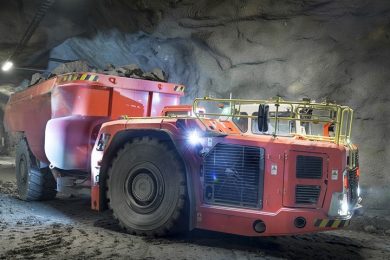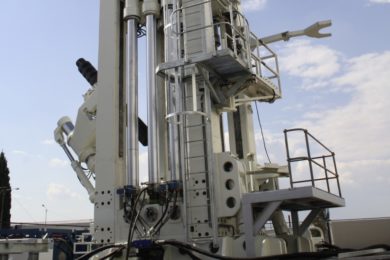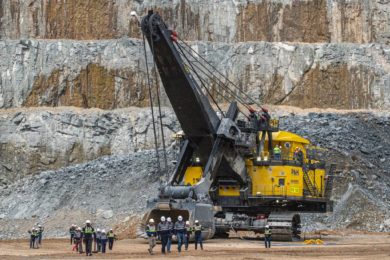In the latest issue of its Solid Ground magazine, Sandvik Mining and Rock Technology outlines the latest news for its automated underground trucks. “The mining truck is a proven standard solution for most underground haulage applications, as the 500,000 operating hours of automated Sandvik trucks over the decades testify. Yet the workhorse of underground haulage is not immune to today’s pressures to innovate and evolve. Key trends include replacing diesel with lower-carbon fuel sources and growing reliance on sensors to monitor mobile assets. Sandvik Mining and Rock Technology’s new generation of mining trucks replaces distributed and hazardous underground operations with centralised hubs and autonomous vehicles.”
The ‘Smart’ Sandvik productivity approach is to operate fewer but bigger trucks – to accomplish more work with a smaller fleet amplified by automation. Furthermore, a smaller fleet of high-capacity trucks reduces underground congestion. “Our capability to offer efficient matching three-pass loading productivity pairs of loaders and trucks over a capacity range of 15 to 63 t, which greatly boosts overall productivity, is unique in the entire industry,” says Mark Ryan, product line manager for underground trucks at Sandvik. “The newest additions are Sandvik TH551i, with a capacity of 51 t for tunnel sizes of 5 x 5 m, and Sandvik TH663i, with a capacity of 63 t for tunnel sizes of 6 x 6 m.”
All the new features and upgrades aim at tangible improvements in productivity, profitability and safety. “More advanced mining automation is a key to many of the new improvements,” says Jarkko Ruokojärvi, product line manager for automation at Sandvik. “The vehicle control and management system of the new trucks is fully integrated with both the AutoMine Trucking system for entirely autonomous haulage traffic and the OptiMine system for data collection and reporting. This built-in automation readiness with the AutoMine onboard package ensures quick and easy installation and start-up even as a retrofit.”
OptiMine complements AutoMine Trucking with a data collection and reporting capability to provide visibility over the entire haulage fleet. Production, utilisation and condition KPIs can be visualised and analysed to support production decisions and predictive maintenance. The system supports conventional USB data transfer, Wi-Fi networks and also data-bearer application for handheld devices in areas with no network coverage. As a modular solution, OptiMine can be expanded to include location tracking, scheduling and task management functionalities.
AutoMine trucking enables both haulage level and decline ramp applications. An isolated haulage loop of autonomous trucks can cover several underground areas. In decline ramp use, a specific ramp is isolated for autonomous trucks. While unmanned haulage during shift changes and blast clearing is an obvious application, continuous autonomous operation is also possible by dedicating an entire decline for truck haulage. The resulting automated production cycle is supervised from a remote location, potentially with multiple units under each system operator. The higher utilisation rate, boosted by added operational hours, directly translates to a higher tonnage.
Improved safety is another key driver for increasing mining automation. Removing people from potentially hazardous areas simply means less risk. AutoMine Trucking relocates vehicle operators from the mine environment to an ergonomic control room. Working alone is eliminated, which further reduces fatigue. In this context, “remote” can mean anything from the mine office at the surface to a work-space in the nearest town.
Additional safety features include a proximity detection system interface for flexible connectivity with third-party control systems. A trainer seat helps ensure the safety of new crew members learning their jobs in real-life conditions. The on-board jacking system, tyre monitoring system and easy ground-level access for maintenance tasks improve the efficiency and safety of the maintenance crew. A key productivity feature of the new trucks is the integrated weighing system (IWS). As the mines go deeper and tramming distances increase, assessing the payload by guesswork is not sufficient anymore. Every tonne counts and each haulage trip must consistently carry up a full payload. IWS has provided consistent accuracy rates of 93 to 94% in operational use since 2013.
The Sandvik TH663i has wider axles, which increase the stability of the vehicle by 15%. This enables an upgrade to a new, larger and stronger 40-cubic-metre dump box from the standard size of 36 cubic metres. “In terms of profitability, the new intelligent mine trucks essentially offer increased production with no increase in fixed costs. Multi-machine control and improved operating discipline can reduce operating costs by up to 50%. Better availability and improved performance mean that mines can achieve the same production volume with fewer trucks.
The addition of four to eight productive hours each day, which otherwise would be wasted for blast clearance, can increase production by as much as 30% compared with earlier Sandvik trucks. A site trial in early 2017 at a northern European mine operating in highly demanding conditions verified the benefits of the new intelligent mining trucks teamed up with AutoMine Trucking. New, deeper-lying ore bodies represent a cost-effectiveness challenge for this mine. Larger automated trucks allow for a smaller fleet, reducing congestion. The team of an automated loader and truck enabled continuous operation also during blast clearance and yielded a production increase of 10–15%, validating the viability of the concept in a demanding ramp haulage application. “With the next generation of automation on the horizon, the benefits to mining are clear. Productivity and employee safety will improve, and it’s another step forward in profitability.”










